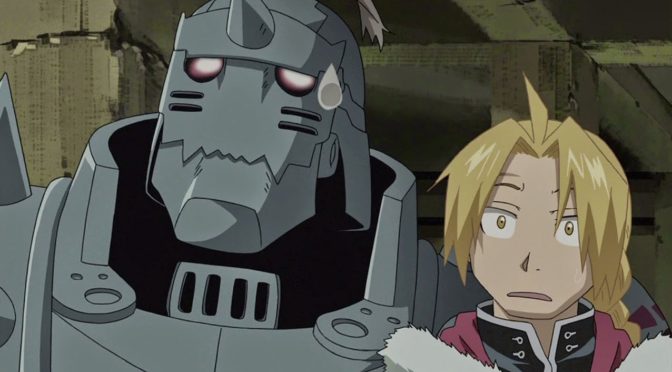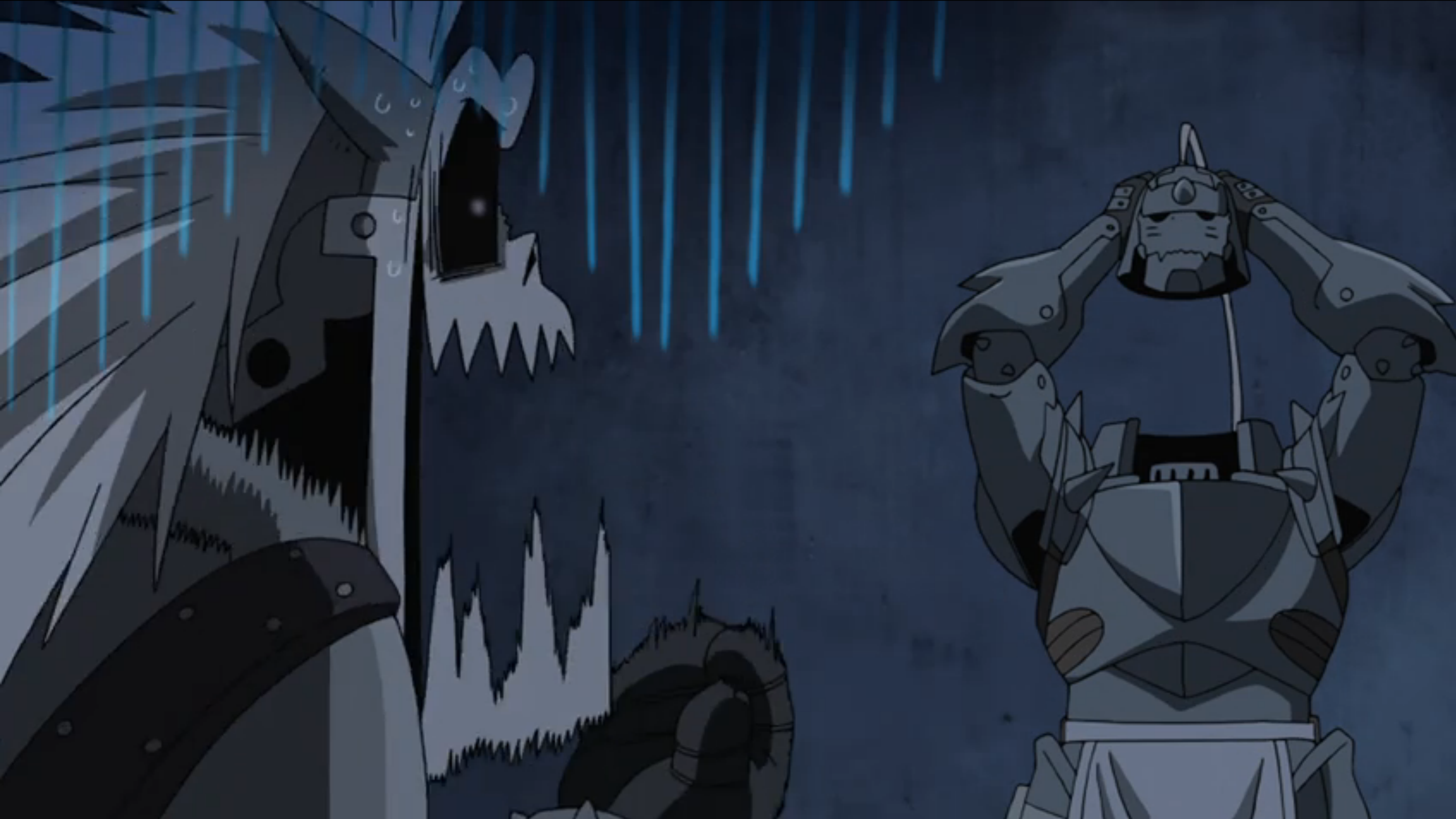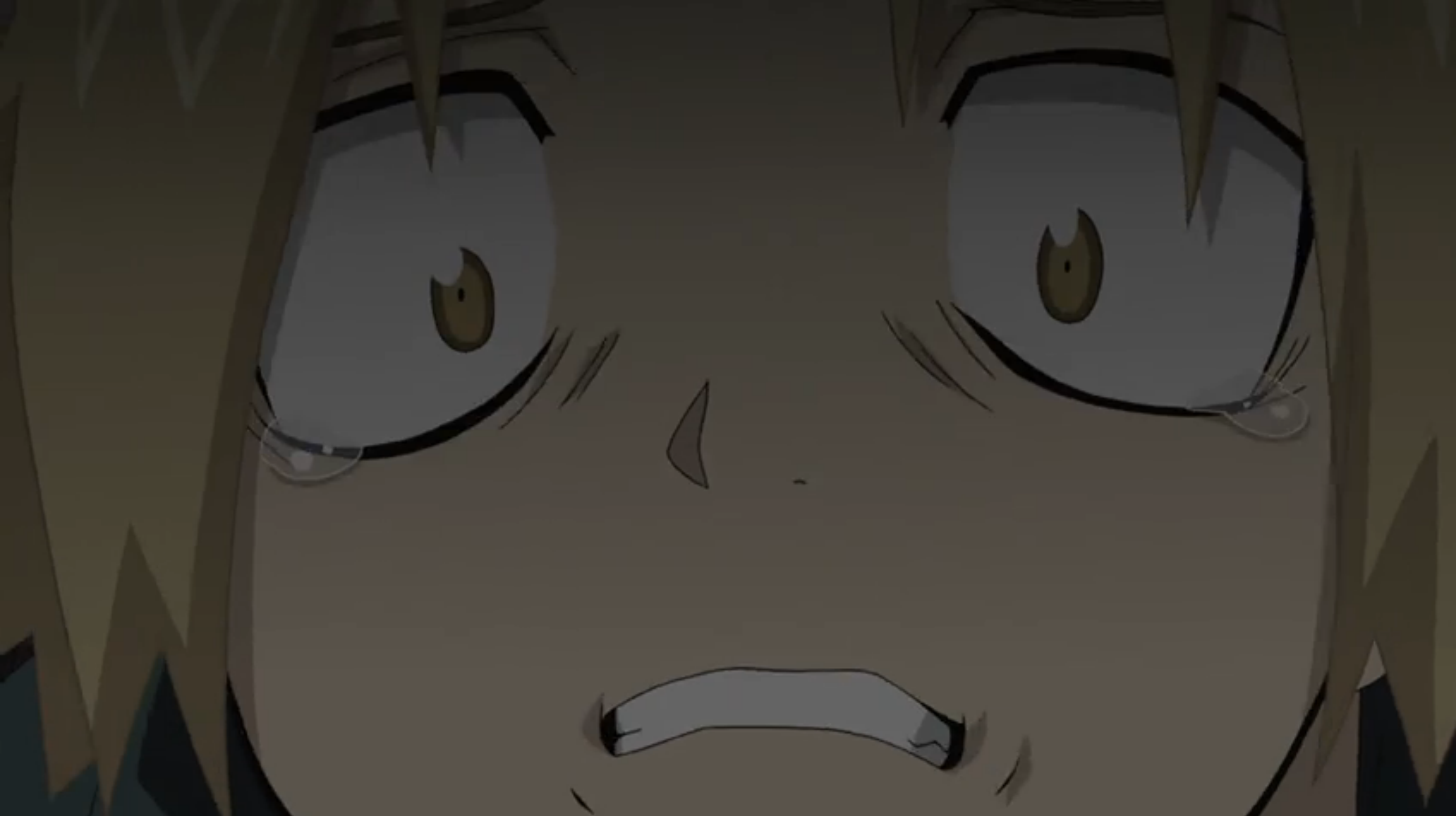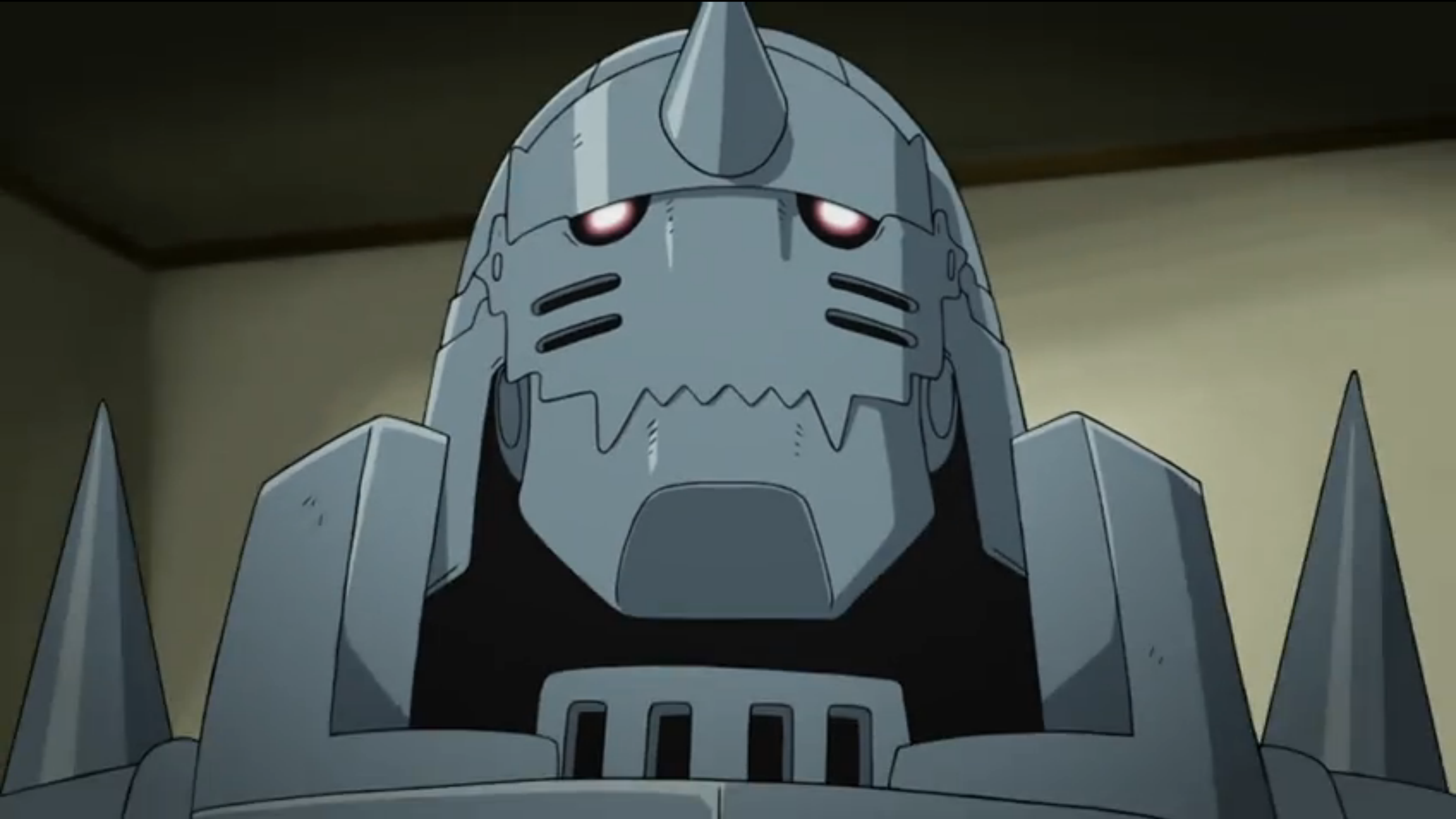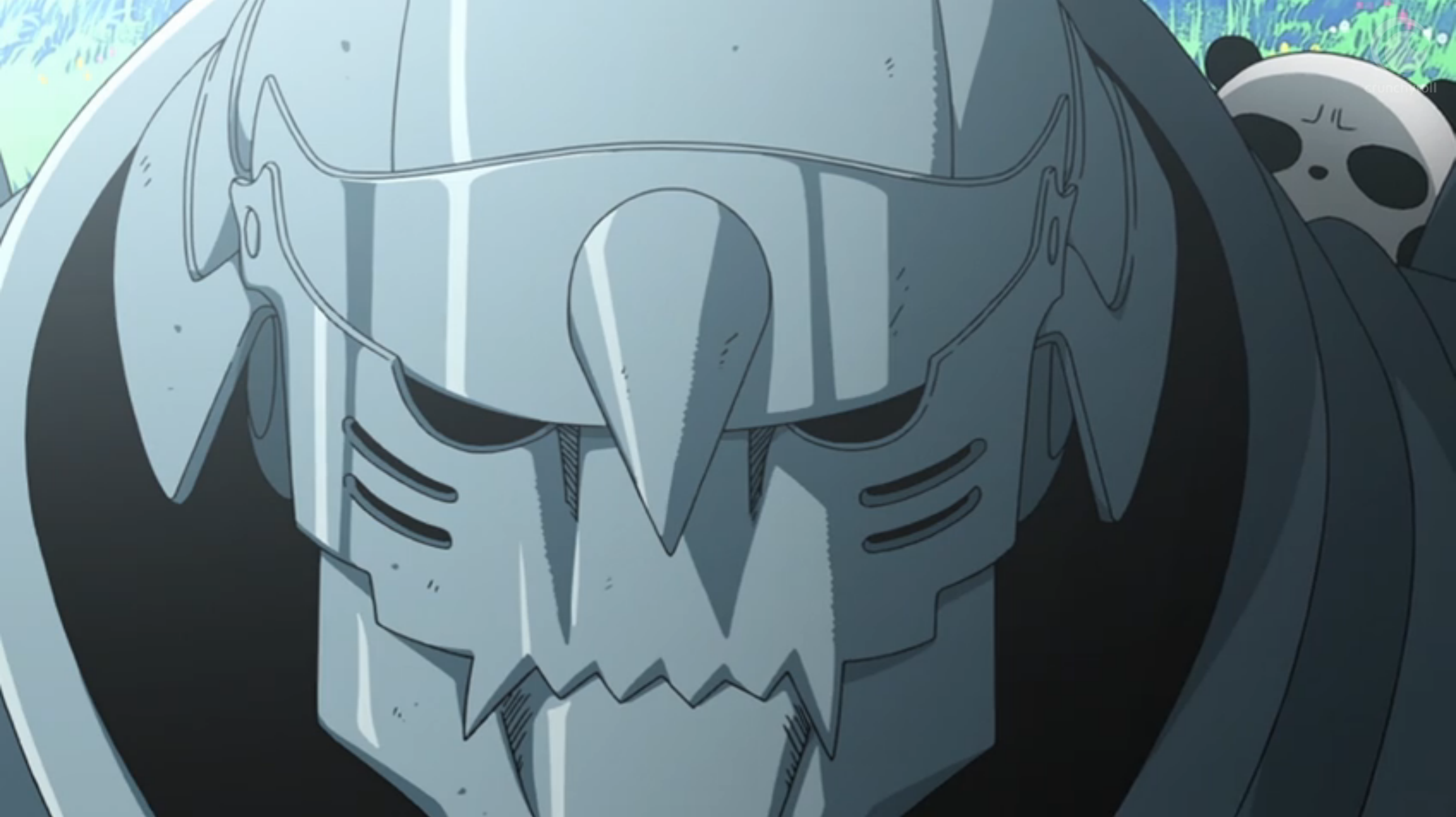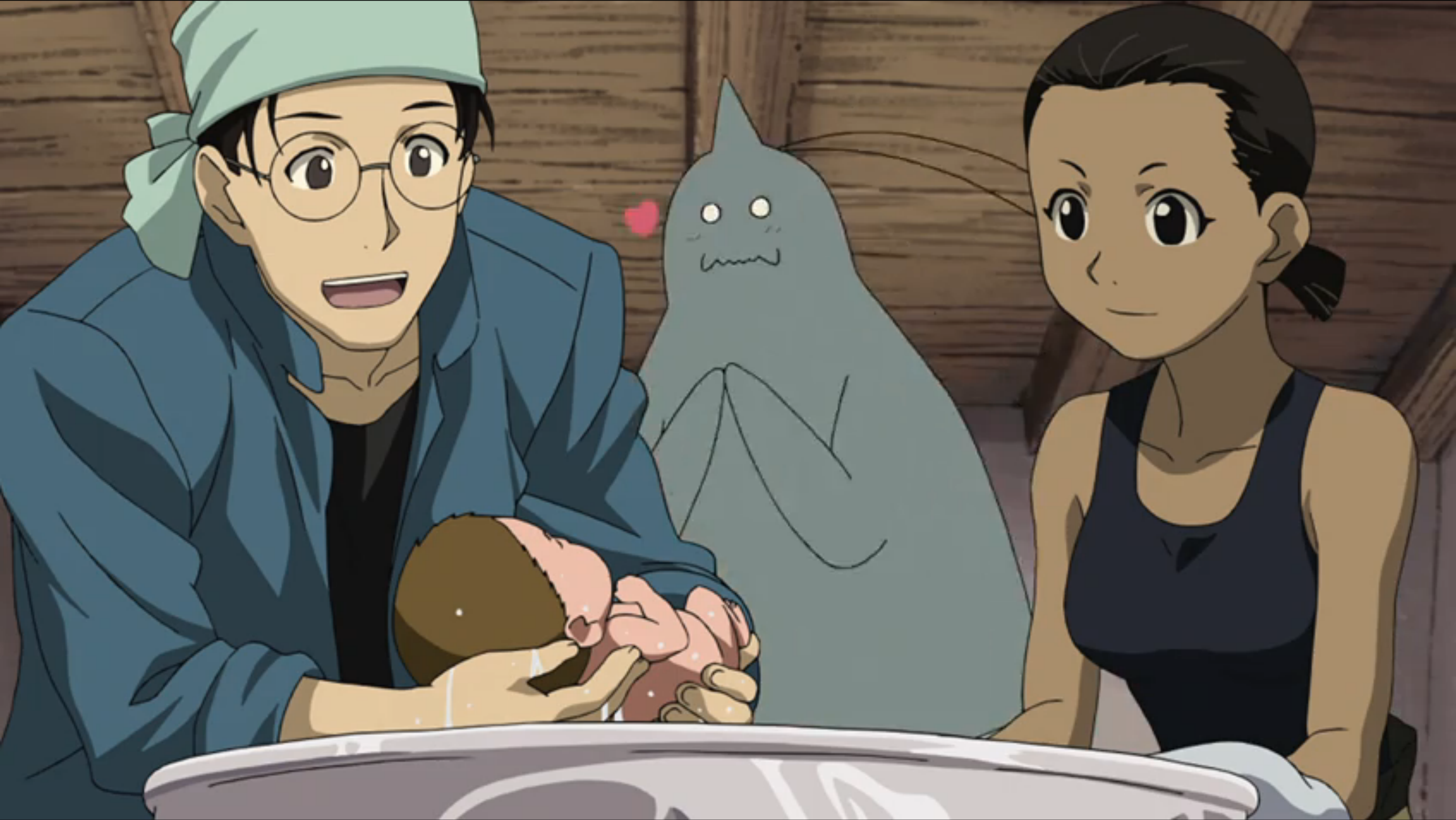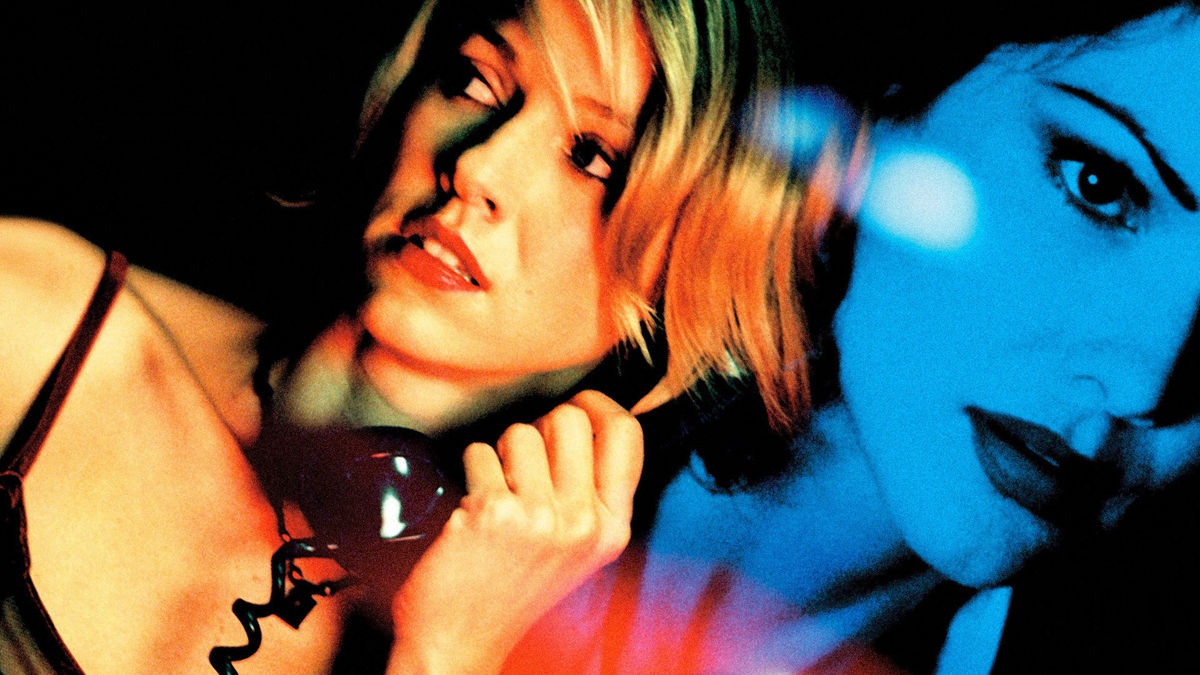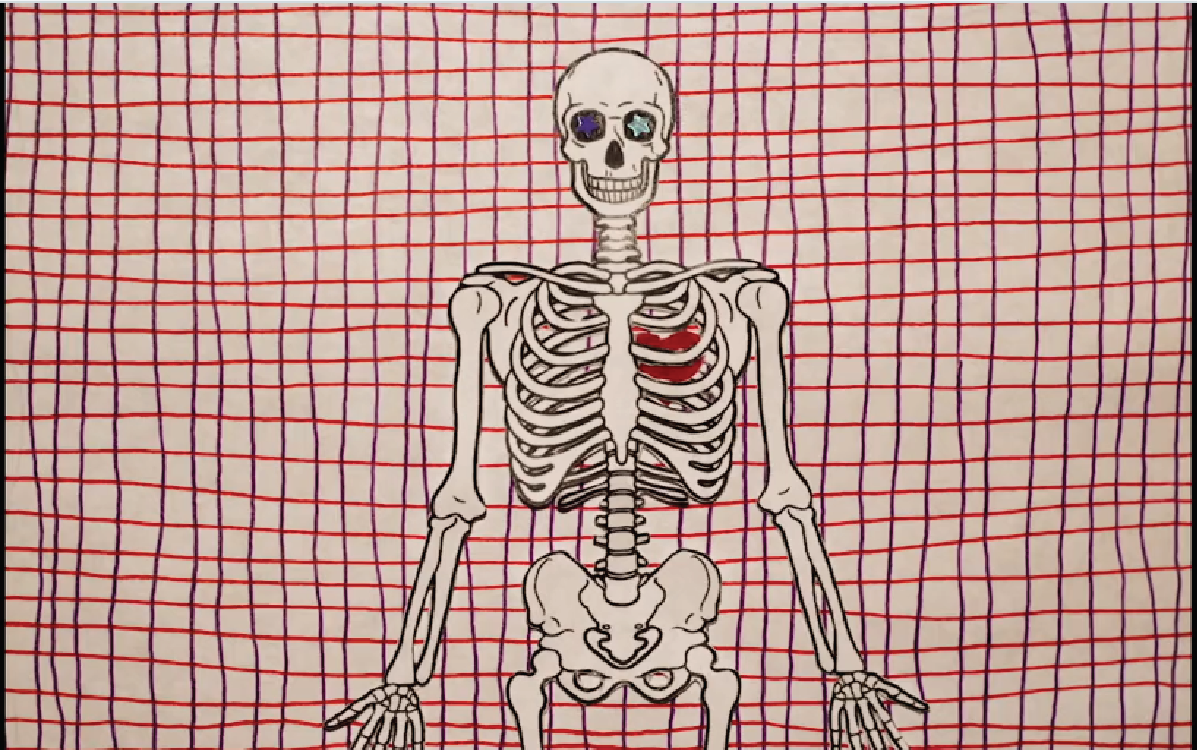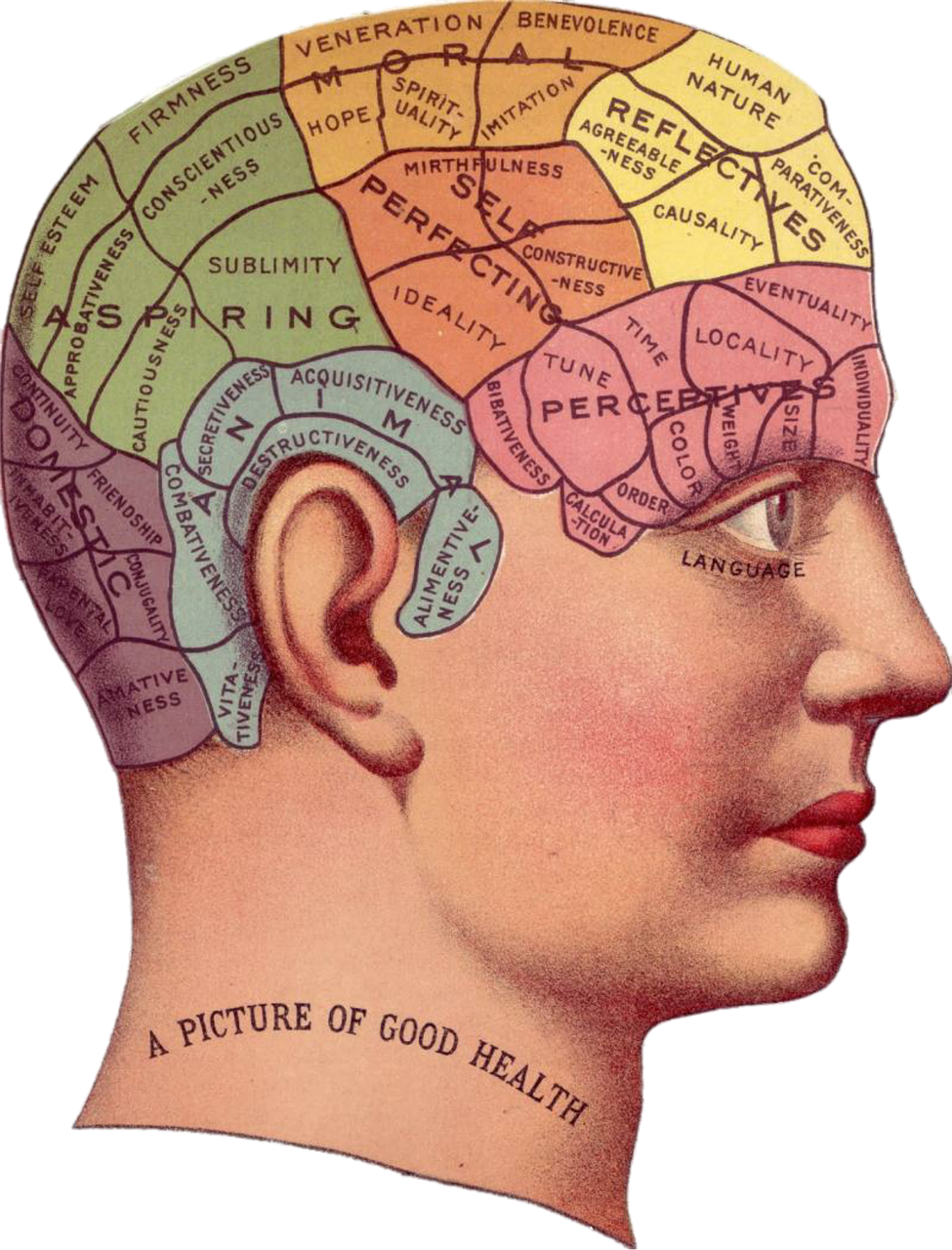by Brendan Decicio
This paper utilizes the Japanese anime Fullmetal Alchemist: Brotherhood to evaluate different uses of facial close-up. Drawing heavily from the theoretical works of Bela Belaz and Maya Deren, the examination reveals that the seriously realistic and absurdly impossible are often juxtaposed in anime, yet do not contradict each other. Instead, the combination of realistic close-up and “super- deformed” aesthetic is employed equally to demonstrate a variety of emotional responses in recognizable, stylized ways.
In episode 8 of Fullmetal Alchemist: Brotherhood, a fight ensues between two armored men, Alphonse and Barry (00:09:03-00:10:58). A series of close-ups on their helmets intensifies the scene, their hidden eyes glowing with determination. Suddenly, Alphonse punches off the helmet of his opponent. Eyes glowing widely, Alphonse tips back his helm in shock as he sees that his adversary is merely a hollow suit of armor. Barry smugly recounts his past as a murderer whose soul had been ripped from his body and bound to a suit of armor, creating a perfect enslaved warrior. However, when his ominous story and darkened face fail to frighten Alphonse, this serious moment makes an abrupt shift for humor: the murderer’s once immutable helmet now changes to dramatic expressions of outrage, shock, and disappointment, even transforming to cracking stone for a moment, complete with blue anxiety lines dripping above his head. His outrage melts into shock and fear when Alphonse lifts his own helmet and reveals he is similarly hollow.
Though such a rapid transformation from a dark and dramatic tone to a heightened stylization of pure humor may be foreign to Western audiences, it is a common occurrence in Japanese anime. Shows such as Fullmetal Alchemist: Brotherhood use both realistic close-ups with subdued motion, a favorite of Bela Baláz, and warped sets of features that abandon the reality of the show for a realm of exaggerated emotion called “super- deformed.” This transition is similar to Maya Deren’s theories on stylization and the warping of filmic reality. While the Balaz and Deren styles seem to contradict one another, an analysis of the faces in Fullmetal Alchemist Brotherhood shows an example of both techniques combined to produce effective and passionate storytelling.
Fullmetal Alchemist: Brotherhood follows the young Elric Brothers, Edward and Alphonse, in a world dominated by alchemy: the ability to magically change the structure of materials in their environment. The two brothers are not typical for their age: Edward has a mechanical arm and leg, and Alphonse is a soul bound inside an empty suit of armor. The loss of limbs and body occurs when they break the taboo of human transmutation, attempting to bring their mother back from the dead. The endeavor not only costs them their bodies, it also is unsuccessful. In order to restore their bodies, they journey in search to find the philosopher’s stone—a mythical object that can break the fundamental law of alchemy (equivalent exchange). Despite emphasizing serious themes of genocide, human sacrifice, sin, redemption, and the nature of God, Fullmetal Alchemist: Brotherhood often moves swiftly between dark and light tones. These transitions rely upon facial expressions to set the intended dramatic mood, demonstrated through realism and humor of the “super- deformed” breaking of reality.
The two methods of displaying facial emotion in anime, then, assist greatly in the exploration of the close-up’s importance. Bela Baláz’s theory focuses on the close-up and, more specifically, the art of microphysiognomy —the interplay of the smallest aspects of the face to convey not a singular emotion but rather layers of feeling through the “polyphonic play of features” (Braudy and Cohen 202). Responsively, Maya Deren discusses how film develops true creative power as filmmakers distance themselves from restrictive realism. Japanese anime not only uses both the hyper-realistic minutiae of the face and the Deren-like abandonment of reality but also finds ways to interweave the two. Thus, Fullmetal Alchemist: Brotherhood becomes a prime venue for studying the play between these theories. It is not this paper’s intention to imply that these theories lead to the genesis of anime’s techniques, as that is reductionist and ethnocentric. However, Japanese anime reflects these two concepts in dynamic and enlightening ways. A comparison will give solid examples of the theories’ effectiveness and the perhaps unexpected aspects of their interplay.
The more profound moments of the show often feature the Baláz style close-up. Moments of horror, fear, apprehension, defiance, conflict, and inner strength are especially prone to being highlighted through such a method. It may be difficult to comprehend how these human emotions could be visible by closing in on an animated face. They are, regardless, but as Baláz puts it, “[g]ood close-ups are lyrical; it is the heart, not the eye, that has perceived them” (Braudy and Cohen 139). A perfect human likeness is not required to properly display strong emotions through a close-up but there are some distinct differences of application between the Baláz close-up and the Fullmetal Alchemist: Brotherhood one.
When analyzing the close-up, Baláz focuses on microphysiognomy . The characters in Fullmetal Alchemist: Brotherhood lack the musculature of live characters, which complicates the application. Yes, animators may try to replicate this microphysiognomy , but as Maya Deren explained, it will never be perfect: “A painting is not, fundamentally, a likeness or image of a horse; it is a likeness of a mental concept which may resemble a horse.” The fact that anime is made up of drawings both challenges animators to replicate natural polyphonic play and also frees them to create their own movements and facial features to display emotion that a face of flesh cannot portray.
Fullmetal Alchemist: Brotherhood contains multiple instances of simultaneous efforts to recreate human facial expression and to manufacture emotion with non-human motion. In episode 2, Edward reacts to losing his brother and his leg in their failed attempt to resurrect their mother (00:10:53). This is one of the most emotionally raw moments of the entire series, and the close-ups mimicking live human facial expressions intensify it. The emphasis on his open mouth demonstrate his body’s urge to scream (which of course he does). At first, his eyes are open wide, as if unable to look away from the horrific scene, yet the addition of crease lines near the nose and a single emerging tear, reveal the pain he feels and the hint that he will soon succumb. The next cut confirms this, as he collapses: eyes now firmly shut in a wince, brow furrowed, teeth clenching. And then he looks at what was created by his alchemy: his eyes widen, his mouth opens, the lines on his face now transitioning from a display of physical pain to one of fear and shock (00:10:59-00:11:06). These physical facial reactions are all prevalent in live-action cinematography, and therefore play well into Baláz’s close-up. In fact, this directly parallels his study of Asta Nielsen’s polyphonic play of features: “[the] expression changes only by a scarcely perceptible and yet immediately obvious nuance” (203). These scenic aspects are a direct attempt to mimic the microphysiognomy of the face, an attempt which Baláz would certainly applaud.
Also notable are the ways in which these close-ups defy normal microphysiognomy. Upon seeing the alchemically constructed monstrosity, Edward’s irises—not just his pupils—contract. As he continues to watch this, his irises and pupils begin to tremble and shake. Neither of these reactions are normal emotional responses in humans, and for most, they are physically impossible. Yet they match perfectly with the lyrical nature of the close-up. This nearly imperceptible eye movement, counterpointed by the stillness of the rest of his body, gives the impression of one overcome with raw emotion through an artistic inversion of a trembling body. Animating eye motion is simpler and cheaper than animating a full body. At the same time, the motionlessness of the body can hint at fear, rage, or pain locking the character in place—while the activity of the eyes reflect the activity within. Though this movement is in contrast to human microphysiognomy, it remains an effective means to present emotion. As Maya Deren put it, “Inasmuch as the other art forms [e.g. animation] are not constituted of reality itself, they create metaphors for reality” (66).
This sequence, then, is a single great example of Baláz and Deren working together. Baláz would likely appreciate this demonstration that powerful emotion can be elicited by closing in on the face, where the tiniest of micromovements can reveal the innermost mental state. Meanwhile, Deren, having said that “the concept of realism. . . is an absurd redundancy which has served merely to deprive the motion picture medium of its creative dimension,” would prize that a key focus of this close-up is an emotion-eliciting, yet completely unrealistic, movement (67). Polyphonic play of features has here been synergized with filmic metaphor, forming a complicated but successful synthesis of both theorists.
One of the greatest ways in which this concept of microphysiognomy is challenged in Fullmetal Alchemist: Brotherhood is through the character of Alphonse Elric. As a soul misplaced into a suit of armor, he is physically incapable of changing expressions. There is no shifting of muscles and no clenching of teeth; only the two glowing representations of his eyes resemble human facial movement in any direct sense. In spite of these limitations, Alphonse exemplifies the power of subtlety in displaying emotion and is possibly one of the best examples of Baláz’s close-up.
Despite having a shiftless face, the angle of Alphonse’s animation (or camera angle equivalent) manages to project a wide variety of emotions. For example, in episode 25, Alphonse has lost his brother because a monster named Gluttony swallowed him. His face is displayed from above; his helmet’s chin is lowered, and the lines of his upper jaw are minimized; the glowing orbs are temporarily absent, suggesting closed eyes (00:16:31). This closeup powerfully depicts sorrow emanating from a face whose features are locked. Other emotions are possible as well, such as in the brief moment in episode 9 where Alphonse is shocked by Edward slamming his fist down on a dinner tray (00:15:42). In contrast to the image in episode 25, this one is displayed from a lower angle, with orbs glowing brighter than usual (implying a wide-eyed expression). And, the helmet is tipped back, as if caught in a head-jerking loss of balance. This moment still captures a human expression of shock despite Alphonse’s fleshless state. And, throughout the series, the hollow brother’s play of emotions is just as vivid as any fully human character’s in the show.
It is entirely possible that much of Alphonse’s emotion is created through the use of Kuleshov style montage. After all, his use of a single face to display a dramatic range of emotion through the juxtaposition of the shots around it would be particularly effective with Alphonse, as his helmet is a template more blank than the average human face. However, if this were the sole way for him to portray emotion, there would be no need for the show’s frequent close-ups of Alphonse. As previously demonstrated, one can detect emotion in the helmet even if looking at a still frame. Yes, juxtaposition contributes greatly to Alphonse’s simulated emotions but the power of his close-ups are apparent, regardless, when observed throughout the show.
In contrast to Alphonse’s typically immutable features, careful watching reveals that, at times, Alphonse’s face does indeed change and morph into expressions. This is no contradiction to the above analysis, as these transformations do not occur in the reality of the show. Suan states, “within Asia’s artistic traditions, there is a long history of unreality in ‘art,’ and Japan is no exception” (171). This is a manifestation of an anime trope called “super- deformed,” or “chibi,” as it has been nicknamed. The “super- deformed” transformation is the temporary mutilation of a character’s body in a “shrunken and childlike manner,” often including the enlargement of the eyes and head as well as hyperbolic body contraction (Anime Vice, 00:00:39). It is used almost exclusively to bring humor and silliness into the show. Since Fullmetal Alchemist: Brotherhood deals with very dark themes, its frequent use of “super- deformed” may be surprising; but this is intentional, as Suan points out: “the ‘warped’ expressions can come off as elastic and playful. . . Fullmetal Alchemist: Brotherhood utilizes [hyperbolic bodily contortions] to break the tension in the series” (263). If the previous examples emphasized Baláz style close-ups with only minor aspects of Deren-like filmic metaphor, then “super- deformed” transformations are predominantly Deren-like metaphor with aspects of Baláz microphysiognomy.
Despite the usual transformations that take place, the most intriguing aspect from a Baláz-styled lens is the use of codified signals of emotion. Instantly recognizable visual cues, these codified signals are fairly standardized across the Japanese anime genre. They include “the sweat feature as an icon of the state of stress, worry or shame; the huge and exaggerated vein to convey anger or frustration; and the famous ‘gloom lines’ of purple color located above or behind the character as a representation of malaise, fatigue or terror” (Horno-Lopez 44). A common example is the “exaggerated vein,” which is four curved red lines appearing on or floating above the temple of a “super- deformed” character going through a humorous bout of rage. It is noteworthy that these signals are almost always derived from human biology: a single drop of sweat to indicate frustration and two drops to show surprise. For blushing, either the vein bluges or pink circles and lines form on the cheeks. For crying, waterfalls of tears form. All of these responses originate from microphysiognomy which normally require close-ups to see. Inso, anime verifies Baláz’s idea that “the silent facial expression, isolated from its surroundings, seem[s] to penetrate to a strange new dimension of the soul” (Braudy and Cohen 203).
This is an example of a “super- deformed” Alphonse in the background, complete with two codified signals: a floating red heart for love—or seeing something he considers adorable—and cheek lines simulating blushing (Episode 11, 00:17:02).
This is a “super- deformed” Edward, with a super large grin and black eyes, both symbols of an almost evil joy. Note the background has been replaced with a solid color, demonstrating that this representation is happening in an emotional reality and not a physical one (Episode 3, 00:14:40).
This “super-deformed” transformation does, however, take this isolation to an extreme. The micro becomes macro, in this situation, with the “camera” remaining stationary. For example, a single drop of sweat will often be the length of half of a character’s face. Furthermore, sometimes these codified symbols are not attached to the body at all but are floating beside or above the head, thus separating these aspects of human physicality to a Daren level of creative reality. In many moments throughout the show, Alphonse becomes “super- deformed,” allowing his normally immobile helmet to become stretched and frown, with large white eyes accompanied by the representational sweat drop. This metamorphosis isn’t taken literally, of course. Alphonse does not magically gain the ability to sweat or frown. Instead, as Suan explains, “The transformations in the visuality . . . of the character are always shown in a particularly codified way and describe to the viewer the inner traits of the character in their reaction” (261). These are hyperbolized representations of emotion. In Fullmetal Alchemist: Brotherhood, the fact that these mutations temporarily leave the physical reality of the canonical world is emphasized by the dramatic colored backgrounds which often replace their world as they become “super- deformed.” The viewer has left the characters’ physical world and travelled into their emotional one.
In a way, these deformities are playing with Baláz’s close-up: they display normally tiny facial features prominently. However, the swift, exaggerated movements, the enlarging and shrinking of features, and the distant “camera positioning” show that this isn’t Baláz’s close-up. The heightened state that exists even beyond the reality of a fictional show reflects Maya Deren’s theory on film and “animated paintings.” Her theory, focusing dominantly on how to use abstractions of film, argues that film has “become” a reality. By accepting the existence of a diegetic reality, these “super- deformed” segments clearly become moments of break within this reality. Paralleling Deren’s interest in using creative geography to examine psychology, this transition shows a stylized version of character psychology. “Separate and distant places can not only be related but can be made continuous by a continuity of identity and movement,” Deren stated, describing ways in which film can reflect an artistic realm outside of reality. These “super- deformed” moments do just that; identity and movement are maintained by carrying out a reaction through the transition between filmic reality and unreality.
On the whole, the seamless transition from diegetic reality to unreality is as smooth as the transformation of the faces within the show. True, Western audiences may need time to adapt to such a method, and some may be repelled by it entirely; however, these applications of both microphysiognomy and “super- deformed” allow anime such as Fullmetal Alchemist: Brotherhood to become a distinctive form of filmic art. Though Maya Deren and Bela Baláz probably never expected to see the techniques they wrote about so intertwined and displayed together, Fullmetal Alchemist: Brotherhood nonetheless artfully displays and mixes their theories. In doing so, it presents a compelling method for demonstrating emotions in animated characters. The balance between reflecting human physicality and entirely abandoning it, once an audience is used to the conventions, creates a spectrum of emotion that allows the viewer to follow swift narrative changes and delve deeper into character psychology. Yes, faces within the show magically shift as if constantly being transmuted, and because of this can only be accepted within the realm of animation where magic is believable. But isn’t that simply fitting?
Works Cited
“3 Minute Expert: Super- deformed Anime.” Youtube, Anime Vice, 19 January 2010, www.youtube.com/watch?v=bF4Od6G7EcU.
Braudy, et al. “Film Theory and Criticism Introductory Readings.” NP: Oxford UP, 2016. Print.
Deren, Maya. “Cinematography: The Creative Use of Reality.” The Avant Garde Film: A Reader of Theory and Criticism, 1978, pp. 60-73, learningsuite.byu.edu/plugins/Upload/fileDownload.php?fileId=e6ffa2e3-dLwp-K7kM-biNl-G38d7affa098.
Irie, Yasuhiro, director. “Fullmetal Alchemist Brotherhood.” Crunchyroll, 2009, www.crunchyroll.com/fullmetal-alchemist-brotherhood.
Horno-LÃ3pez, Antonio. “The Particular Visual Language of Anime: Design, Colour and Selection of Resources.” Animation Practice, Production & Process, vol. 5, no. 1, January 2016, pp. 39-56, DOI:10.1386/ap3.5.1.39_1.
Kern, Adam L. “The Anime Paradox: Patterns and Practices through the Lens of Traditional Japanese Theater by Stevie Suan.” The Journal of Japanese Studies, vol. 42, no. 1, 2016, 156-161, DOI:10.1353/jjs.2016.0020.
